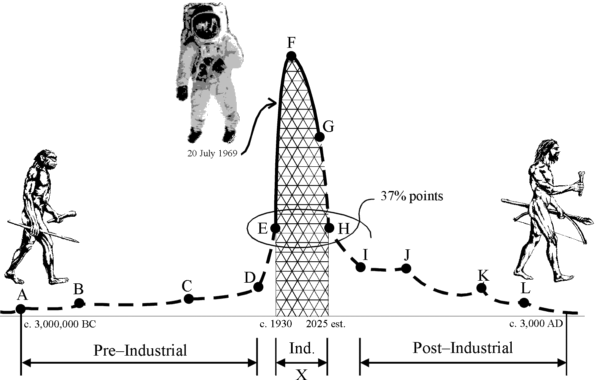The Olduvai Theory of Industrial Civilization

1. Pre-Industrial Phase [c. 3,000,000 BC to 1765]
- A = Tool making begins (c. 3,000,000 BC)
- B = Fire use begins (c. 1,000,000 BC)
- C = Neolithic Agricultural Revolution (c. 8,000 BC)
- D = Watt's steam engine, 1765
Interval D-E is a transition period.
2. Industrial Phase [1930 to 2025, estimated]
- E = Industrial Civilization is defined to begin in 1930 when the leading-edge value of energy-use per person reached 37% of its peak value.
- F = Peak of Industrial Civilization, c. 1978: confirmed by historic data published by BP, IEA, USCB, UN, etc.
- G = World average energy-use per person continues to fall, 1996
- H = Industrial Civilization is defined to end when energy-use per person shrinks to 37% of its peak value, forecast to occur by 2025. Life-expectancy (X) is estimated to be less than 100 years.
Interval H-I is a transition period.
3. Post-Industrial Phase [c. 2100 and beyond]
- J, K, and L = Recurring future attempts at industrialization fail.
An in-depth analysis has been published in The Social Contract, Winter 2005-2006: The Olduvai Theory. Energy, Population, and Industrial Civilization.
"The Olduvai Theory states that the life expectancy of industrial civilization is approximately 100 years: circa 1930-2030. Energy production per capita (e) defines it. The exponential growth of world energy production ended in 1970... Average e will show no growth from 1979 through circa 2008 ... The rate of change of e will go steeply negative circa 2008 ... World population will decline to about two billion circa 2050 ... A growing number of independent studies concur...."
© 1996, 1997
INSTITUTE on ENERGY and MAN

Richard C. Duncan Ph.D., Director
updated 2006 February 7
updated 1997 December 18


